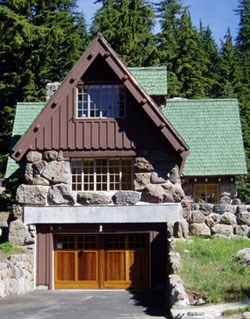|
Two rehabilitated historic structures provide the base of operations for the Science and Learning Center and augment other park facilities previously established. These include the former Superintendent and Chief Naturalists’ Residences. These two historic structures comprise the nucleus of facilities aimed at supporting visiting scientists, artists and educators. 
The Superintendent’s Residence is one of 50 structures in the National Park Service designated as a National Historic Landmark for its architectural significance. This building is nationally renowned because it depicts the best elements of rustic architecture as constructed by the National Park Service. This structure provides office space, a reference library and small meeting and conference facilities for Center users. The main floor of the building is open to the general public to interpret the historic significance of the structure and to enlighten the public to the mission of the Center. We will strive to maintain the decor of this building, and in particular the public areas, in the style of the 1930’s period when the house was used as the Superintendent’s private residence. Original furniture has been rehabilitated and reused where practical and new pieces have been fabricated in the style and appearance of the historic furnishings. The Chief Naturalist's residence is about 50 yards from the Superintendent’s house. It is a historic structure built in the rustic style and listed on the National Register of Historic Places. This structure provides cooperators with temporary housing and kitchen facilities for visits lasting from a few days up to two weeks. The Residence is reserved on a space available basis. Cooperators with approved research permits or project proposals may request accommodations. Learn more about what is available at the Residence and how to reserve it by visiting our Residence Page. We have a number of other facilities to support visiting scientists, teachers and pupils. In the park there are small to large scale conference and lecture facilities at our Steel Information Center, Crater Lake Community Center and the Rim Community Building. These facilities can accommodate up to 100 participants for lectures, workshops, seminars and conferences. Library facilities that include most of the published and unpublished manuscripts relating to Crater Lake research are available on site to visiting researchers and educators. Museum and archive collections are also available for comparative research and teaching. 
A modern water laboratory is available for a variety of chemical analyses and a full service Geographic Information System (GIS) and global positioning network has been established to assist with remote sensing and other spatial data needs. Finally, through our own ongoing research, the park has available a wide variety of technical sampling equipment that can be loaned to visiting scientists and students. We also have a dedicated research vessel for logistical support on Crater Lake. |
Last updated: March 31, 2012
